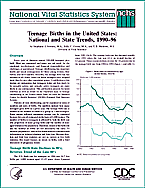
 |
|
 |


http://www.hhs.gov
Teen Birth Rates
Down
in All States
New Government Report on Teenage Birth Rates Includes State Rates by Race and Ethnicity
Embargoed For Release
10 a.m. E.S.T., April 30, 1998
For Publication in Newspapers
Dated May 1,1998
NCHS Press Office (301) 458-4800
paoquery@cdc.gov
 National
Vital Statistics System, Teenage Births in the United States: National
and State Trends, 1990-96 (PHS) 98-1120 (4/30/98)
National
Vital Statistics System, Teenage Births in the United States: National
and State Trends, 1990-96 (PHS) 98-1120 (4/30/98)
View/download
PDF 196 KB
Birth Data Web Page
HHS Secretary Donna E.
Shalala announced today that, according to a new HHS report, the teen
birth rate declined substantially nationwide from 1991 to 1996. Secretary
Shalala announced the findings at a reception honoring the first
anniversary of the National Campaign to Prevent Teen Pregnancy.
According to this new government report focusing solely on teenage childbearing, between 1991 and 1996, teen birth rates declined for white, black, American Indian, Asian or Pacific Islander, and Hispanic women ages 15-19. The rate for black teens -- until recently the highest -- experienced the largest decline, down 21 percent from 1991 to 1996 to reach the lowest rate ever reported for blacks.
The latest state-by-state data, from 1995, show that teen birth rates have declined in all 50 states and the District of Columbia. Among the states with the lowest rates--under 35 births per 1,000 teens--were Vermont, New Hampshire, Minnesota, North Dakota, Maine, and Massachusetts. Areas with double that rate at 70 or more births per 1,000 women aged 15-19 included the District of Columbia followed by Mississippi, Texas, Arizona, New Mexico, Arkansas, Nevada, Georgia, and Alabama.
"This report shows that our concerted effort to reduce teen pregnancy is succeeding," said Secretary Shalala. "The federal government, the private sector, parents, and caregivers are all helping send the same message: Don't become a parent until you are truly ready to support a child."
Shalala also noted the important work of the National Campaign to Prevent Teen Pregnancy and its 1998 National Campaign Honorees, who are implementing innovative teen pregnancy prevention programs across the U.S.
The Campaign was created in response to President Clinton's 1995 State of the Union challenge to "parents and leaders all across this country to join together in a national campaign against teen pregnancy to make a difference." The honorees were recognized in the categories of: building common ground, corporate leadership, effective programming, male involvement, media innovation, state leadership, and teen leadership in preventing teen pregnancy.
The new National Center For Health Statistics report, "Teenage Births in the United States: National and State Trends, 1990-96" brings together the latest and trend data to profile the teenage mother. It has teen birth rates for each state by race and Hispanic origin to help explain some of the differences across states. While the decline in the teenage birth rate varied among States, those with both high and low rates succeeded in achieving significant reductions between 1991 and 1995. The variation between states reflects, in part, national patterns by race and ethnicity.
Each year in America, almost 500,000 teenagers give birth. The preliminary U.S. birth rate for teenagers in 1996 was 54.7 live births per 1,000 women aged 15-19 years, down 4 percent from 1995 and 12 percent from 1991 when the rate was 62.1. These recent declines reverse the 24 percent rise in the teenage birth rate from 1986 to 1991. There has been success in lowering the birth rate for both young and older teens, with rates for those 15-17 years of age down 12 percent between 1991 and 1996 and the rate for those 18 and 19 down 8 percent.
Still, teen birth rates are higher today than in the mid-1980's when the rate was at its lowest point, 50-53 births per thousand teens age 15-19. The national teen birth rate was at its highest in 1957, at 96 births per 1,000 women ages 15-19. However, most teenagers giving birth in the 1950's and for the next two decades were married while the vast majority of teenage mothers today are unmarried.
Teenage mothers are much less likely than older women to receive timely prenatal care, are more likely to smoke and less likely to gain the recommended weight during their pregnancy, and more likely to have a low birthweight infant, as shown in the annual reports from NCHS' National Vital Statistics System.
The new HHS report on teenage childbearing is the first in a new series of statistical summaries designed as an easy-to-read presentation of the key data and facts on critical public health issues. The National Center for Health Statistics is a part of the Centers for Disease Control and Prevention. The new report is available and can be downloaded from the NCHS Home Page on the Internet. Copies are also available from NCHS at (301) 458-4800.
This page last reviewed
October 06, 2006
1-800-232-4636 |
